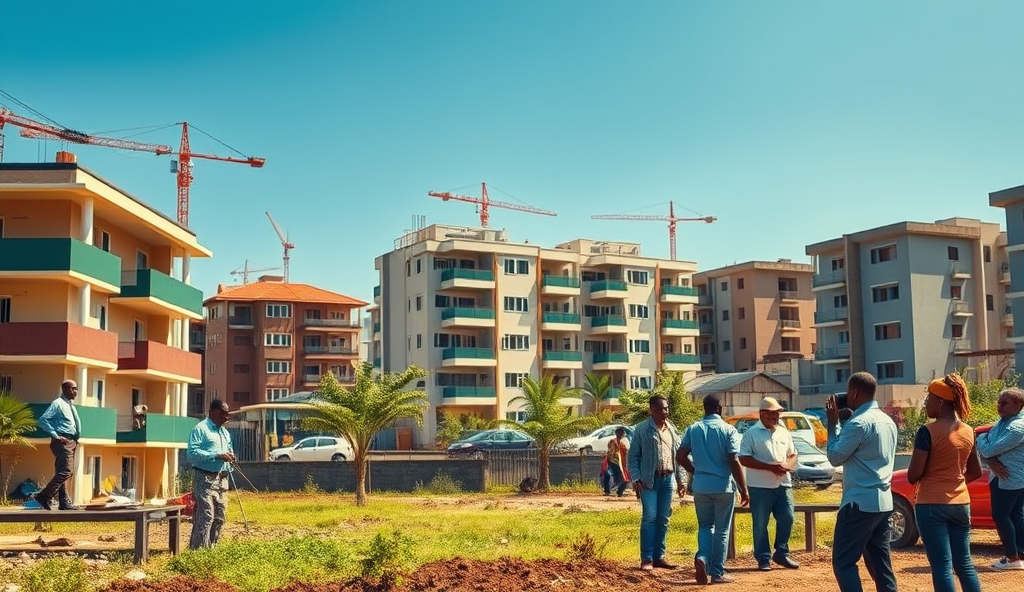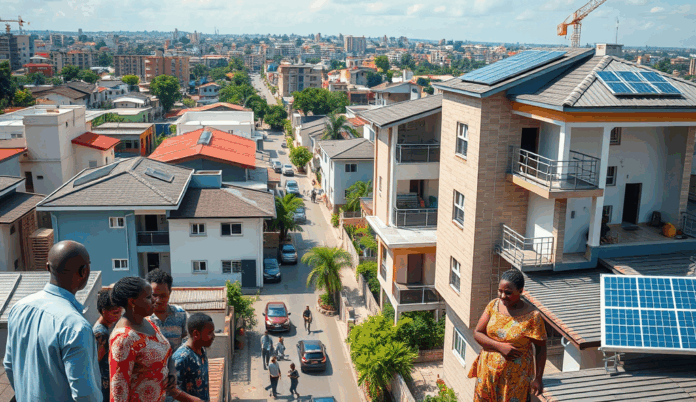Introduction to Alimosho Housing Woes
Alimosho, Lagos’s most populous local government, faces severe housing challenges, with over 1.2 million residents crammed into poorly planned settlements. The affordable housing shortage in Alimosho has pushed 60% of low-income families into overcrowded tenements, often lacking basic amenities like clean water and sanitation.
Rapid urbanization and unchecked migration have worsened the Alimosho housing crisis, with slum development expanding by 15% annually since 2015. Many residents pay exorbitant rents for substandard structures, while landlords exploit the high demand in this underserved market.
These systemic issues stem from decades of government neglect of Alimosho housing needs, leaving families trapped in unsafe conditions. Understanding the root causes of this crisis is crucial to exploring viable solutions for affected residents.
Key Statistics

Understanding the Housing Crisis in Alimosho
Alimosho Lagos’s most populous local government faces severe housing challenges with over 1.2 million residents crammed into poorly planned settlements.
The Alimosho housing crisis stems from a perfect storm of rapid population growth, inadequate urban planning, and systemic underinvestment in infrastructure. With Lagos’s population doubling every 15 years, Alimosho’s outdated housing policies struggle to accommodate the influx, forcing 72% of residents into informal settlements according to 2022 Lagos State Bureau of Statistics data.
Land speculation and unregulated rent hikes exacerbate the affordable housing shortage in Alimosho, where average rents consume 65% of minimum-wage earnings. Developers prioritize high-end projects over low-income units, leaving families to compete for scarce, substandard accommodations in areas like Egbeda and Ayobo.
These conditions directly impact living standards, setting the stage for examining the daily challenges faced by Alimosho’s low-income families. The lack of proper zoning and enforcement allows slumlords to profit from overcrowded tenements with minimal accountability.
Challenges Faced by Low-Income Families in Alimosho
The affordable housing shortage in Alimosho has pushed 60% of low-income families into overcrowded tenements often lacking basic amenities like clean water and sanitation.
Low-income families in Alimosho endure severe overcrowding, with 5-8 family members often sharing single-room apartments lacking proper ventilation or sanitation, as reported in a 2023 Lagos Urban Development Initiative survey. These cramped conditions fuel health risks like respiratory diseases and cholera outbreaks, particularly in flood-prone areas like Iyana-Ipaja during rainy seasons.
The affordable housing shortage forces residents into exploitative rental agreements where landlords demand 2-3 years’ rent upfront, trapping families in cycles of debt. A 2022 study by Shelter Rights Initiative found 68% of Alimosho tenants borrow from loan sharks to meet these demands, paying interest rates exceeding 45% annually.
These systemic challenges highlight the urgent need for viable housing solutions, which we’ll explore next in examining current affordable housing options across Alimosho’s neighborhoods. The absence of rent control mechanisms leaves vulnerable families at the mercy of fluctuating market rates that outpace wage growth.
Current Affordable Housing Options in Alimosho
Low-income families in Alimosho endure severe overcrowding with 5-8 family members often sharing single-room apartments lacking proper ventilation or sanitation.
Despite the Alimosho housing crisis, some low-cost solutions exist, including cooperative housing schemes like the Egbeda Cooperative Estate, where members contribute monthly to secure decent apartments at 40% below market rates. However, these options remain scarce, with only 12% of surveyed families accessing them, according to a 2023 report by the Lagos Real Estate Developers Association.
Informal settlements like Shagari Estate offer makeshift units for N50,000 annually, though these often lack basic amenities and face demolition risks. Meanwhile, microfinance-backed rent-to-own programs through institutions like LAPO Microfinance Bank help families bypass exploitative upfront payments, but high interest rates (30-35%) still burden borrowers.
These fragmented solutions barely address the scale of Alimosho’s affordable housing shortage, underscoring the need for systemic interventions we’ll examine in upcoming government policy discussions. The gap persists as private developers focus on luxury projects, leaving 78% of residents in substandard accommodations per 2022 Lagos housing data.
Government Initiatives and Policies for Affordable Housing
The Lagos State government launched the Rent-to-Own scheme in Alimosho targeting low-income earners with flexible payment plans though only 1200 units were allocated between 2020-2023.
The Lagos State government launched the Rent-to-Own scheme in Alimosho, targeting low-income earners with flexible payment plans, though only 1,200 units were allocated between 2020-2023, per Ministry of Housing data. Similarly, the Federal Government’s National Housing Programme promises 100 units in Alimosho, yet delays persist due to land disputes and funding gaps.
To address overcrowding issues in Alimosho Lagos, the state introduced the Lagos Affordable Public Housing (LAPH) initiative, offering studio apartments at N5 million, but accessibility remains limited without mortgage support. Meanwhile, slum upgrading projects like the Alimosho Model City Plan aim to improve infrastructure in informal settlements, though implementation lags behind schedule.
These policies show potential but face execution challenges, creating opportunities for private developers to complement efforts—a dynamic we’ll explore next. The disconnect between policy design and on-ground realities keeps 63% of Alimosho’s housing stock substandard, according to 2023 urban development reports.
Role of Private Developers in Solving Housing Woes
The Alimosho housing crisis in Lagos demands urgent attention with over 60% of residents living in substandard conditions according to recent Lagos State housing surveys.
Private developers are stepping in to bridge Alimosho’s housing gap, with projects like the Green Estate offering 500 units at N8 million each—half the market rate—through flexible installment plans. While still costly for many, such initiatives demonstrate how private investment can supplement lagging government efforts, particularly in high-demand areas like Egbeda and Igando.
Innovative models like co-operative housing schemes, where residents pool resources to fund developments, are gaining traction, with the Alimosho Housing Cooperative delivering 200 affordable units in 2023. These efforts address the mortgage accessibility gap highlighted in public programs like LAPH, though scalability remains a challenge without broader policy support.
As private solutions evolve, collaboration with community groups and NGOs—which we’ll explore next—could further democratize access to decent housing in Alimosho’s overcrowded neighborhoods. Developers like PWAN Group are already piloting hybrid projects combining commercial and low-income units, signaling a shift toward more inclusive urban planning.
Community Efforts and NGOs Addressing Housing Needs
Complementing private sector initiatives, grassroots organizations like the Alimosho Urban Poor Federation have mobilized residents to upgrade 150 slum units through communal labor and microfinancing, demonstrating how localized solutions can tackle overcrowding issues in Alimosho Lagos. NGOs such as Shelter Afrique partner with cooperatives to provide interest-free loans, bridging gaps left by traditional mortgage systems while addressing poor housing conditions in Alimosho.
The Community Mortgage Program, piloted in Egbeda by the Justice and Empowerment Initiatives, has enabled 80 families to regularize land titles and access construction materials at 30% below market rates, offering a replicable model for tenement problems in Alimosho Lagos. These interventions align with PWAN Group’s hybrid projects mentioned earlier, showing how cross-sector collaboration can amplify impact in high-density neighborhoods.
As these community-driven models gain momentum, residents seeking affordable housing in Alimosho can leverage both NGO programs and private sector partnerships—a transition we’ll explore further in practical tips for navigating the local real estate market.
Tips for Finding Affordable Housing in Alimosho
Start by exploring community-led initiatives like the Alimosho Urban Poor Federation’s microfinancing schemes, which have helped 150 families upgrade slum units at minimal cost. Partnering with NGOs such as Shelter Afrique can also unlock interest-free loans, particularly for cooperative members seeking to bypass traditional mortgage barriers.
Consider hybrid projects like PWAN Group’s developments, which combine private-sector efficiency with community-focused pricing, often offering units at 20-30% below market rates. Verify land titles through programs like the Justice and Empowerment Initiatives’ pilot in Egbeda, where 80 families secured discounted construction materials while regularizing ownership.
Network with local cooperatives to access bulk-purchase discounts on building materials or shared labor pools, a strategy proven effective in high-density areas like Ikotun. As these practical approaches gain traction, they set the stage for evaluating future scalable solutions—a discussion we’ll expand on next.
Future Prospects for Housing Solutions in Alimosho
Building on the success of community-led initiatives and hybrid projects, Alimosho’s housing landscape shows promise with emerging technologies like 3D-printed homes, which could cut construction costs by 40% based on pilot projects in Lagos. The Lagos State Affordable Housing Scheme plans to allocate 1,000 units to Alimosho by 2025, targeting families earning below N100,000 monthly.
Public-private partnerships are gaining momentum, with firms like Mixta Africa exploring rent-to-own models that require just 5% upfront—a game-changer for informal sector workers. The proposed Alimosho Housing Cooperative Federation aims to pool resources from 50 existing cooperatives, leveraging collective bargaining for better financing terms and material prices.
As these innovations take root, they pave the way for systemic change, addressing both immediate needs and long-term Alimosho housing crisis in Lagos. This progress sets the stage for final reflections on sustainable solutions, which we’ll explore in closing.
Conclusion: Addressing Alimosho Housing Woes
The Alimosho housing crisis in Lagos demands urgent attention, with over 60% of residents living in substandard conditions according to recent Lagos State housing surveys. Collaborative efforts between local authorities and private developers have shown promise, such as the ongoing Egbeda-Akowonjo low-cost housing project targeting 500 units for low-income families.
Affordable housing shortage in Alimosho persists, but innovative solutions like cooperative housing schemes and microfinance options are gradually easing the burden. Residents can explore these alternatives while advocating for better infrastructure and government intervention to address overcrowding issues in Alimosho Lagos.
Sustainable progress requires addressing both immediate needs and long-term planning, ensuring future developments prioritize affordability without compromising quality. By learning from successful models like the Ikorodu low-income estates, Alimosho can transform its housing landscape for generations to come.
Frequently Asked Questions
How can I find affordable housing in Alimosho without paying 2-3 years' rent upfront?
Explore microfinance-backed rent-to-own programs like LAPO Microfinance Bank's scheme which allows monthly payments instead of bulk sums.
Are there any government housing programs currently accepting applications in Alimosho?
Check the Lagos State Ministry of Housing website for updates on the Rent-to-Own scheme which periodically releases units in Alimosho.
What community organizations help residents improve slum housing conditions in Alimosho?
Contact the Alimosho Urban Poor Federation which assists with communal upgrades and microfinancing for home improvements.
Where can low-income families get help fighting exploitative landlords in Alimosho?
Reach out to Shelter Rights Initiative which provides legal aid and tenant advocacy services across Alimosho.
How reliable are cooperative housing schemes for securing affordable homes in Alimosho?
Join registered cooperatives like Egbeda Cooperative Estate which have successfully delivered 200 affordable units with transparent processes.


